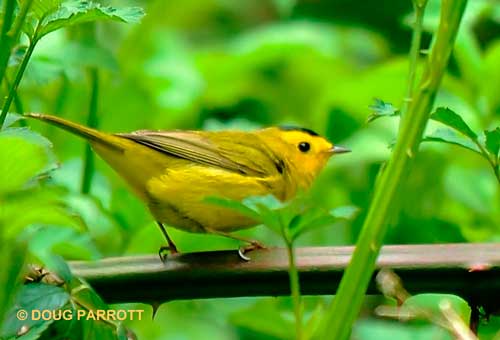Yesler Swamp is not a place of grand vistas or wide, sweeping views of nature. It is a place of twisty trails, hemmed in by plants who seem bent on regaining the ground they have lost to vigorous weeding by volunteers. You have to watch your step in here. Tree roots the size of speed bumps zigzag across the path. Cut logs installed as stepping stones are slippery when wet, and they are always wet. It’s dark, too, where the willows weave their spidery branches together overhead. They clack, you know, when the wind blows.
And yet I know of no place in all of Seattle more filled with the intimate beauty of nature. Here, you and the wild are close — nose to nose, as it were. I discovered this yesterday as I was edging my way along the oozy trail. Spring has come late this year, the coldest in Seattle’s recorded history. Birds that would normally have migrated long ago held up somewhere south as long as they could. Now, in mid-May, they are coming in a rush, stacked up at the Fill like airplanes waiting to land at Sea-Tac.
I figured Yesler Swamp would be an irresistible draw for the insectivores: the warblers, vireos, and flycatchers that are my favorites in all the bird kingdom. I set down my camp stool where the north loop emerges into a rare open space, and waited. Within a minute or two, I heard the unmistakable song of a Wilson’s Warbler, singing almost in my ear. Wilson’s Warblers are tiny bundles of sunshine: bright yellow underneath, shaded yellow on the back, topped by a black yarmulke on the head. Who knew there were Orthodox warblers? They’re gorgeous birds, but I have to admit, they don’t have much of a song. It’s more a hurried series of chirps strung together without much variation in note. If you can imagine a klezmer singer doing rap — that’s a Wilson’s Warbler.
Nearby, another bird not noted for operatics was hunting for flies: a Pacific-slope Flycatcher hard at work. Pacific-slope Flycatchers are birds of the shady forest. So nondescript are they as to almost defy identification: brown on the back, grayish in front, a couple of whitish wingbars, a white eye-ring. That’s about it. Their “song” is equally plain: a high-pitched peep/pause/peep-peep/pause/PEEP. This is music?
Maybe not, but it is surely magic. For both these birds have flown all the way from Central America to come to this one spot, in the heart of a big city. Here, they find the seclusion they seek to make new warblers and flycatchers, to continue the cycle of life to the next generation. It is here that they sing their little all, and it is here that they share their lives with those of us willing to stop a moment and listen to the symphony of life all around us.

